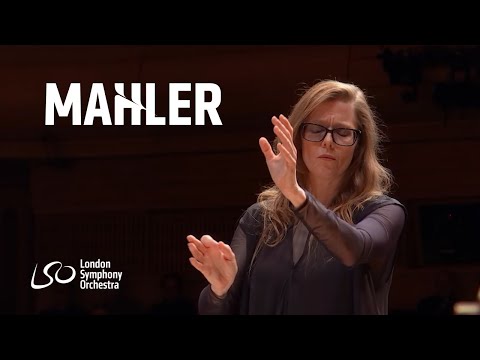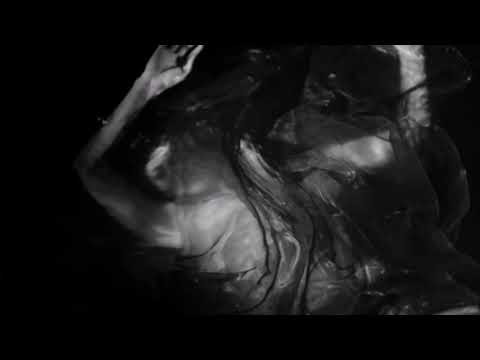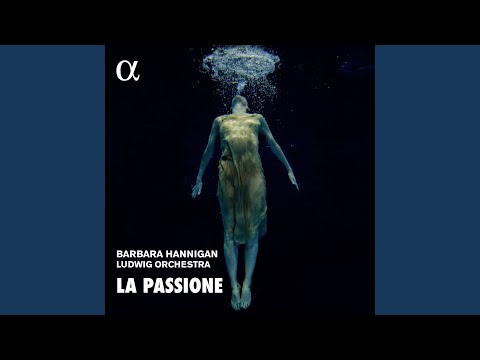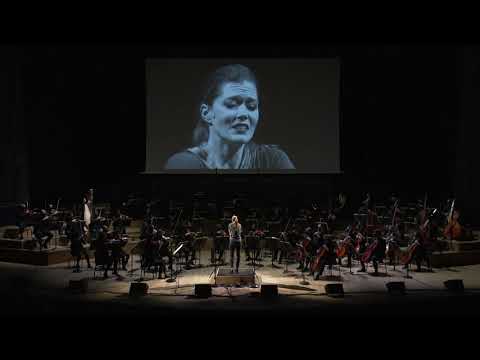The conductor and singer Barbara Hannigan, 53, is possessed of such irrevocable musicianship and presence that, during her May 9 recital of works by Messiaen and John Zorn at the Pierre Boulez Saal in Berlin, with the pianist Bertrand Chamayou, I caught myself in the casual assumption that she was immortal, like Messiaen’s Catholic God (“Chants de terre et de ciel”) or a member of Zorn’s Finnish pantheon (“Jumalattaret”). On May 15, the Iceland Symphony Orchestra announced Hannigan as the ensemble’s new chief conductor and artistic director, starting in the 2026–27 season. I’ve sometimes wondered what was taking orchestras so long to appoint her to one of those jobs; for Hannigan, though, the announcement came at the right time. I spoke with her about musical and psychological leadership, her dramaturgical approach, fear—and what she has in common with Barbra Streisand.
VAN: You’re starting your new post as chief conductor and artistic director of the Iceland Symphony Orchestra in August 2026. What will your programming priorities be like there?
Barbara Hannigan: Everybody’s asking me that, but you haven’t seen any answers in interviews because I can’t talk specifically. Iceland said in their statement that one of the reasons that the attraction between us was so immediate and exciting was that we both love innovative programming. I’m known for the programs I make, from audiences but also from players. I think we can go even further in Iceland, which is exciting. You can see on the World Wide Web how I combine works for orchestra—not only full orchestra, but sometimes I’m adding solo or chamber works within a program, drawing on players from the orchestra, bringing the focus [from] very small [to] very, very big within the same program.
I think everybody picks up that my programs have a red thread in a dramaturgical way. If I go to a museum or an art gallery, I’ve found that my senses have always been most excited by the exhibits that are presenting visual art in that way: It’s more interesting to me if I see this dramaturgical thread, as opposed to, These are all the works of this artist and his contemporaries, or the sandwich program. That’s not so interesting to me. It has to have this emotional center that then drives the intellectual.
You’ve talked about needing the freedom to choose the music that you do as a soloist and guest conductor. It seems to me that a lot of people are a little less free when they’re the artistic director of a symphony orchestra. Are you thinking about that?
I don’t know. I guess I’ll find out. As a conductor, I’ve always been able to create the programs that I bring. I’ve never, ever encountered orchestras saying, “Will you please come and conduct this program?” That’s just never happened. It’s always just been, “Will you come? What would you like to do?” And that’s also been the case with my bigger collaborations, like the principal guest conductor position that I have with the Gothenburg Symphony Orchestra or the associate artist [position] with the London Symphony Orchestra. In every case, I’ve had freedom, and I think we’ve benefited from giving me freedom. [Laughs.] But of course it’s a huge learning curve for me. It’s very exciting to be in this artistic director position: A different kettle of fish, right?
A lot of conductors, when they come to a new orchestra, would do their Beethoven or their Mahler cycle. It sounds like you wouldn’t want to do that.
Never say never. We’ll see. There might be cycles of some composers. It could be Beethoven and Mahler. It won’t be Bruckner, I can tell you that. [Laughs.]
Why not?
It’s just not me.
What kind of things have you learned from working with conductors as a soloist that you want to apply to your conducting with the orchestra?
That step has mostly passed because I’ve been conducting more than I’ve been singing for the last five years or so. When I started [conducting] I was definitely cross-referencing a lot more. But now conducting is the more prominent [part] of my work anyway. That said, I’m learning all the time, from everybody: I’m learning from every conductor, but also the musicians in the orchestra, the managers. I’m observing all the time: “How does this person manage this group of people?” It doesn’t even have to be in music, because any position of leadership requires management and social and psychological awareness. How do we want to use the situation of power that we are now in; what is the right usage of that?
You were asking about me being a singer. Being a soloist carries, or can carry, a lot of responsibility of leadership as well. And I think I was particularly aware of that because I was often bringing pieces to orchestras that had never been done with that orchestra before. I was the one person that had done that piece ten, 15, 20 times—like [“Let me tell you” by] Abrahamsen. I was usually the factor that had carried the most history with the piece. And therefore I couldn’t ever sit back, because I often had the answers that they needed, even if it was a question from the bassoon. I was often the go-between as the soloist. I like being in the mix; that’s always been my way.
There’s an interview where you compare being a singer versus being a conductor to being like a child versus a parent. How does being an artistic director fit into that metaphor? It’s even more responsibility than being a guest conductor.
You should ask me after my first year. But I think it’s just like conducting—it’s a lot of listening and observing. I’m certainly glad that I’ve waited until this point to go into this. I’ve always been very happy I didn’t start conducting until I was 40, and I’m very happy that I’m not going into a chief conductor position until I’m 55.
There are several really young conductors taking major positions right now, like 28-year-old Klaus Mäkelä with the Royal Concertgebouw Orchestra and the Chicago Symphony Orchestra…
Klaus is an extraordinarily gifted person. I’ve never worked with him, only watched him. But he has a great gift, and there are very few people like him.
But to speak in a more general way: It is something to look at if you have people in the major management positions who are under 30. They certainly need to have been prepared for managing a large group of people and a team onstage and off, some of whom have been working longer than that conductor has even been alive. [Laughs.]
You mentioned the term “red thread” as it applies to program dramaturgy. Do you see a kind of broader red thread in the repertoire you like—between Gershwin and Grisey, for example?
Well, I’ve never put them on the same program. [Laughs.] Maybe if it was a very particular piece of Gershwin, like quite a dark piece. I put Gershwin and Berg together—that definitely works. One of Gershwin’s favorite pieces was the “Lyric Suite.”
With Grisey, my focus has always been the “Quatre Chants.” I put it on the album with the Haydn Symphony No. 49 and [Nono’s] “Djamila Boupacha.” For me, that was a perfect album. It would be a perfect performance, except you wouldn’t put those on a concert together because logistically it would be a nightmare. Financially it would also be difficult. You have to think about those things as well. But it’s a perfect album because you have this very strong theme of crossing.
For me, the red threads are very personal. I like to keep them a little bit mysterious, because I don’t ever want to define someone’s experience. I think that’s why I have never enjoyed, and I try to avoid, pre-concert talks. I don’t mind a post-concert talk, but a pre-concert talk: I really find that leading the witness. I don’t like it when we tell an audience what they should experience or what they should listen for. It’s manipulative. The person should be coming in with whatever they bring to the table and allowed to have their experience. And if they want to talk after, that’s great.
Someone like John Zorn doesn’t even like the audience to have program notes or a text. He wants it super clean. And I can understand that. It’s this leading the witness thing. I think witness is the right word because everybody is witnessing something, but they’re all witnessing something completely different. We have no idea where they came from, what their chemical makeup is that makes them respond to a sound or something visual or even being in a concert hall. I have my red thread, but I realized that even if I have quite a clear idea, I like to leave room for the mystery. In myself, but also for the audience. They will come to their own conclusions or questions.
I never ever go to pre-concert talks either for that same reason.
Yeah. I hate it. Someone telling you, “Listen for this chord,” and then you only obsess about that. And then if you didn’t hear it, it’s like, Oh.
In another interview, you said that you are open about your own doubts and struggles when working with students. Having seen you several times in rehearsals and concerts, you having struggles and doubts is hard for me to imagine—though I believe you of course.
With Equilibrium Young Artists, I brought in a bunch of other people: Daniel Harding, Natalie Dessay, Laurent Naouri, Kasper Holten, Sir Andrew Davis. And there was not one person who did not speak about that as well, whether they refer to it as loneliness, doubt, or feelings of isolation. It’s an important thing to speak about, especially now, when you’ve got Instagram and social media and you’re putting out all the triumphs and all that stuff—the razzmatazz. It’s like that scene in “Chicago” with Richard Gere and Renée Zellweger, when he talks about giving them the Razzle Dazzle. That’s the outward thing right now. But every performer I know has a healthy dosage of doubt all the time. And, let’s face it, fear. You can be courageous and fearful at the same time, and that’s actually pretty normal.
Definitely, it’s just particularly hard to imagine that happening for you, because you’re incredibly controlled and confident.
Yeah, not always. I’m not controlled—there are certain parameters of control, but if you control too much, you’re gripping. If you’re gripping, you’re not free. It’s very changeable. This recital I do with Bertrand [Chamayou], there are nerves and apprehension, but with him it’s special, because we talk about it openly and can help each other through it.
There are only a couple of pieces that I don’t get scared for: Ligeti’s “Mysteries of the Macabre,” [Poulenc’s] “La Voix humaine.” My fear parameter in “La Voix humaine” is very small. I’ve trained it out. Because I know what the brain does if you start going into the What if I don’t make it, What if I forget the words, What if I crack on this note. If you start going down those paths, then you create realities. You make a real path. So it’s a lot of mental discipline work.
Is there a length of time that you kind of have to live with a piece that helps reduce the fear parameter?
Nope. I wish, because there are some pieces I’ve been doing for such a long time, like the Abrahamsen (“Let me tell you”) which I still get nervous about, and other pieces that I could always just roll out of bed and sing (like Ligeti “Mysteries of the Macabre”) without ever feeling nervous. It’s not a length of time or living with something. But the good thing is, when I was younger, I used to avoid certain pieces that triggered the fear for me. It was usually pieces that had very long, exposed, soft lines like the Abrahamsen. If he had written that piece ten years before I wouldn’t have made it, and yet, when he wrote it, I was ready to face that piece. It was a personal triumph for me to be able to do it time and again.
You’ve said that when you were around 40, you achieved a feeling in which “the door to the music is always open and [you] don’t have to look for the key every time.” What was that feeling exactly?
It had to do with a certain connection of the intellect and the heart, and then the whole system clicking in. My path became more clear. Previously, I would have so many extraneous thoughts that interfered; I had interference. That’s what it was: It’s like a radio channel that you can’t always get clearly. Then it was like I finally knew where on the dial it was, and I could consistently find it.
Many artists that have been in the business for a long time will start to speak about how thankful they are that they’re still in it, because your relationship to the music, and your thankfulness that you are able to do this, become deeper and deeper with every year. Maybe because you can see that somewhere there’s an end, whether that’s death or the demise of the instrument or the demise of the physical ability to play the instrument. So it’s like, “Wow, I can still do this. How fortunate.”
The latest from VAN, delivered straight to your inbox
Is that part of the—not the decision, but the pleasure—in doing more conducting now, that it feels like something that you can do longer?
When I started conducting, I really did not have any consideration of, “This will be the long game.” It didn’t enter my mind. I simply started conducting because I knew that it was something I had to try. Then it became more of a constant in my life, because I realized, “Hey, this is also me.” But funnily enough, for some reason—I think just for physical, chemical reasons—my vocal instrument has more longevity than I expected. Which I’m curious about, because that John Zorn piece is not a walk in the park. I haven’t lost range, I haven’t lost power. I just have to be at a state of awareness of what the instrument can still do. But it’s like “Well, gotta keep singing,” because it gives me a lot of joy and also the singing feeds the conducting and the conducting feeds the singing. There’s this wonderful Möbius thing going on.
I was at your most recent Berlin recital, and a friend remarked that your voice was still completely there, but he noticed a slightly darker color. Do you think that’s true?
Yeah, some other people said that too. I think that’s true. Which I’m happy about: Bring it on. Because if there’s a bit more darkness to balance out the light, that’s probably a good thing.
Are you aware that you’re a bit of a gay icon in the classical music world?
No, I didn’t know.
I have some friends who use the nickname “Babs” for you, like Barbra Streisand.
That’s cool. I’m always surprised when I hear from people—like, a lot of metal people like what I do. And I’m such a huge Barbra Streisand fan. So I mean, that’s very cool if there are two Babs out there. ¶
Update, 5/25/2024: An earlier version of this article said Hannigan was starting her position with the Iceland Symphony Orchestra in the 2025–26 season. She is actually starting in the 2026–27 season. VAN regrets the error.
Subscribers keep VAN running!
VAN is proud to be an independent classical music magazine thanks to our subscribers. For just over 10 cents a day, you can enjoy unlimited access to over 875 articles in our archives—and get new ones delivered straight to your inbox each week.
Not ready to commit to a full year?
You can test-drive VAN for one month for the price of a coffee.






